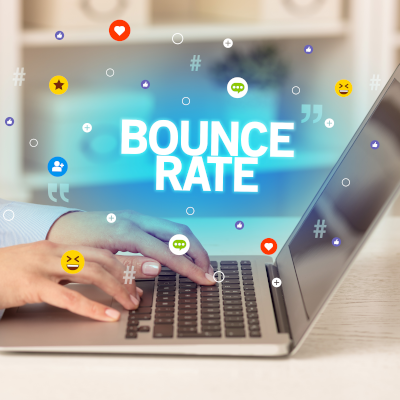JoomConnect Blog
How to Minimize Bounce Rate on Blog Pages
Bouncing is, in most cases, a fun activity. From bouncy balls, to trampolines, to bungee jumping, there are countless ways that bouncing can be seen as a good thing. When it comes to your website, however, bouncing is widely considered the last thing you want your visitors to do. However, this can often be an oversimplification that hides the real problem.
Let’s go over the concept of bounce rate, and what needs to be done to really optimize your website.
First of All, What is “Bounce Rate?”
Let’s consider how someone might behave as they go to your website. Of course, you have the people who would behave the way you want them to: exploring your blogs and service pages to learn more about the managed services you offer and the benefits of subscribing to them. Ideally, these visitors would fill out a form or otherwise give permission for you to contact them, and you’d be off to the races.
Alternatively, someone might go to one of the pages on your website and, after some amount of time, just leave without navigating to any of your other pages. This is what is described as a bounce, and it offers some less-than-good implications—depending on a few different factors.
What Can a Bounce Signify?
Frankly, that depends.
In terms of how bounce rate has traditionally been approached, it tends to mean a few things. As we’ve established, bounce rate is the percentage of single-engagement visits to your website. In layman’s terms, it signifies how many people came to your website, stayed on whatever page they landed on, and clicked back out of your website. By collecting this percentage, Google gets the idea that the webpage didn’t offer what the user hoped (or expected) to find.
This sounds bad, right? Bounce rate, however, isn’t such a one-or-the-other consideration.
Bounces Aren’t Always Bad
The problem with how bounce is measured brings up some potentially misleading flaws that contribute to the widespread belief that “high bounce rates = bad.” The truth of the matter is that a high bounce rate can often be a non-issue, if not a good thing, based on the goal of the website.
Granted, bounce rate can be a sign that ineffective content is present on the page, or there are issues with its accessibility, or that the content on the page isn’t accurately reflected by the keywords that led the user there. However, single-page websites (which have become popular as of late) will inherently have a high bounce rate—there’s just no other option—and some websites actively seek out a high bounce rate. Take Wikipedia for example… Its ideal situation is for a user to find a certain page, find the information they needed, and leave.
In fact, it is fully possible to make your website less usable by focusing too much on decreasing bounce rate. How long would you stay on a website that took two separate pages to describe something that could (and should) have only taken one?
How to Tell the Difference Between Good and Bad Bounces
The key is to consider your visitors’ collective dwell time.
Google actually uses a separate algorithm to determine your website’s bounce rate: the pogo-sticking algorithm. Basically, this tool helps them differentiate between bounces by evaluating the time spent.
While pogo-sticking and bounce sound awfully similar—heck, bouncing is what pogo sticks do—pogo-sticking is exclusively caused by bounces that indicate that a website is attracting the wrong audience based on a search result and dissatisfying them as a result.
In order to establish if your visitors are pogo-sticking away, Google tracks a variety of variables:
- How many search results were selected before the user settles on one of them
- How many additional results are clicked after a particular result is selected
- How high a particular result’s bounce rate is
Combining these factors, Google can tell if you’re causing a pogo-sticking problem if you have a high bounce rate and if many other links are clicked after yours was. If your website has a lot of long clicks (how long the user stays on the page after clicking to it), Google concludes that you aren’t causing any pogo-sticking and ranks you more highly.
Basically, without factoring in how long someone is actively staying on your website, bounce rate doesn’t actually tell you all that much.
Factoring in Dwell Time (and How Different Page Types Impact This)
Let’s consider how the purpose of a particular page can also determine whether or not it is problematic:
- If a page has a low bounce rate and a shorter dwell time, it may be a connection page that does its job well.
- If a page has a high bounce rate and a longer dwell time, it is likely a page that engages the visitor and also delivers what they are looking for without having to link somewhere else.
- If a page has a low bounce rate and a longer dwell time, it’s likely the kind of page many websites (but not all) seek out: a well-designed and useful page that has links to other useful pages.
- If a page has a high bounce rate and a shorter dwell time, however, there may be issues that come from the design of the page itself. This is really what you want to avoid.
How an MSP Can Accomplish the Gold Standard of Long Dwell Time, Low Bounce Rate
Here’s the thing: as an MSP, your business relies on your visitors spending enough time on your website for you to effectively market to them. You want them exploring from page to page, learning as much as they can about your services and—most importantly—the benefits they will see by doing business with you. You want them to spend more time on your site, to take in enough content, so that they’ll be convinced to reach out to you and ask for more information, or even to inquire about signing on to your services.
In light of this, let’s go over a few ways that you can work to minimize your website’s bounce rates:
Make Sure Your Website Offers a Good User Experience
Nobody wants to stay on a website that’s hard to navigate, or makes it difficult to actually take in information or find what it is they’re looking for… regardless of the device they’re using. Most modern Internet users do much of their browsing on a mobile device, so you’ll want to make sure that your website is built to be responsive.
Offer Some Content to Boost Engagement
Look, we have said time and time again that content is king, but now seems like a good time to explore a few reasons why that is. Sure, content helps to make your website seem more authoritative and trustworthy, but that’s just the beginning. Remember what we said about dwell time? The longer the dwell time, the better, as it means that your content is also keeping your developing prospect on your website longer. Content also offers a great opportunity to link to other pages on your website, minimizing bounce rates and helping to gain a few more all-important impressions.
Build (and Test) Landing Pages
There are a few reasons to build a landing page. Let’s face it, not every blog you write will have a clear tie-in to another page on your website, and if one of these blogs serves as a major draw of traffic, your bounce rates could turn against you. Landing pages were designed to solve this exact problem, working to draw in your audience and spoon-feed them calls-to-action to ensure they stay on your website. To add some extra efficacy, it never hurts to do some A/B testing on these pages to make sure the ones you use are the ones that work best.
Refer to Your Numbers
Analytics are some of your best friends when it comes to evaluating your bounce rate—and, if used correctly, whether or not that bounce rate indicates a poor user experience.
An analytics tool will almost certainly give you your bounce rate as a percentage. While somewhere between 50% to 70% is the average for most websites, you’d ideally want to achieve a bounce rate somewhere between 30% to 50%. Bounce rates higher than 70% indicate that there is something wrong that’s impacting your visitor retention, and anything below 20% (while it sounds great) is more indicative of a problem with your tracking tool.
It is also important to pay attention to how long your visitors are spending on your different pages each time they visit. This number, the Average Session Duration, will tell you how quickly people are leaving your pages once they’ve clicked into them.
If This All Seems Like a Lot, We Can Help
Your website should be the centerpiece of your MSP’s marketing strategy. Working with our team can help you get it there. We operate as an MSP ourselves, so everything we do for our clients has been beta-tested in real life by us. Give us a call at 888-546-4384 to find out more about what we offer today, or fill out the form on this page.



